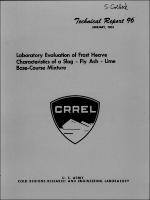Please use this identifier to cite or link to this item:
https://hdl.handle.net/11681/5713Full metadata record
| DC Field | Value | Language |
|---|---|---|
| dc.contributor.author | Kaplar, Chester W. | - |
| dc.date.accessioned | 2016-03-21T16:46:21Z | - |
| dc.date.available | 2016-03-21T16:46:21Z | - |
| dc.date.issued | 1963-01 | - |
| dc.identifier.uri | http://hdl.handle.net/11681/5713 | - |
| dc.description | Technical Report | - |
| dc.description | Abstract: Sixteen specimens of a slag-fly ash-lime base-course mixture were tested for frost susceptibility in the laboratory. Th& mixture consisted of 66% slag, 30% fly ash and 4% lime, by weight. Base courses of this type are being used in certain parts of the country in competition with conventional base-course materials. The slag-fly ash-lime base-course mixture used in these tests consisted of minus 3/8-in. material with 30% finer by weight than No. 200 mesh sieve and 18% finer than 0.02 mm. According to the Corps of Engineers' criteria for base courses, this gradation is classified as frost-susceptible. Different methods of cure treatment were tried and the effect of aging (up to 12 months duration) on frost-susceptibility was observed on 6-in. diam, 6-in. high- specimens. Cure treatment prior to freezing consisted of: 1) curing in oven at 140°F for 7 days ; 2) "moist curing" in wet sand from 1 and 1/2 to 12 and 1/2 months; 3) complete immersion in water for 2 weeks followed by "curing" in wet sand up to 12 and 1/2 months; and 4) no curing. Some specimens were subjected to 5 or 6 cycles of freezing and others to 10 cycles. Specimens were generally frozen uniaxially from top to bottom at a rate of approximately 1/2 in. per day. Test results showed that over-cured specimens heaved insignificantly even after 10 cycles of slow freezing in an open-system test, while non-cured specimens heaved about 15% during a single freezing and were classified to be of low frost susceptibility. In accordance with adopted criteria, based on average rate of heave in mm/day, most, moist-cured and soaked specimens were classified as negligible frost-susceptible although a few approached or were classified as very low frost-susceptible. Specimens cured only in moist sand performed significantly better on the whole than those first submerged in water and then moist-cured. On "moist-cured only" specimens, heaving decreased with increase in curing time. The maximum measured heave of any of the cured specimens, soaked or otherwise, during any one freezing cycle was approximately 0.2 in. and about 3. 3%. | - |
| dc.publisher | Cold Regions Research and Engineering Laboratory (U.S.) | - |
| dc.publisher | Engineer Research and Development Center (U.S.) | - |
| dc.relation | http://acwc.sdp.sirsi.net/client/en_US/search/asset/1015820 | - |
| dc.relation.ispartofseries | Technical report (Cold Regions Research and Engineering Laboratory (U.S.)) ; 96. | - |
| dc.rights | Approved for public release; distribution is unlimited. | - |
| dc.source | This Digital Resource was created from scans of the Print Resource | - |
| dc.subject | Frost heaving | - |
| dc.subject | Frost heave | - |
| dc.subject | Frost | - |
| dc.subject | Roads | - |
| dc.subject | Base courses | - |
| dc.subject | Soils | - |
| dc.subject | Subgrade soils | - |
| dc.subject | Tests | - |
| dc.title | Laboratory evaluation of frost heave characteristics of a slag-fly ash-lime base-course mixture | - |
| dc.type | Report | en_US |
| Appears in Collections: | Technical Report | |
Files in This Item:
| File | Description | Size | Format | |
|---|---|---|---|---|
| CRREL-Technical-Report-96.pdf | 13.51 MB | Adobe PDF |  View/Open |